D.W. Wilkin's Blog, page 27
September 16, 2016
Regency Personalities Series-King’s College London
Regency Personalities Series
In my attempts to provide us with the details of the Regency, today I continue with one of the many period notables.
King’s College London
1829-
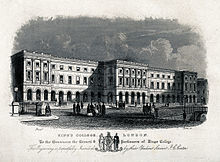
King’s College London
King’s College London is a public research university located in London, United Kingdom, and a founding constituent college of the federal University of London. King’s was founded in 1829 by King George IV and the Duke of Wellington and received its royal charter in the same year. In 1836, King’s became one of the two founding colleges of the University of London. King’s is regarded as one of the world’s leading multidisciplinary research universities, ranked 21st in the world by the 2016/17 QS World University Rankings.
King’s College London, so named to indicate the patronage of King George IV, was founded in 1829 in response to the theological controversy surrounding the founding of “London University” (which later became University College London) in 1826. London University was founded, with the backing of Utilitarians, Jews and non-Anglican Christians, as a secular institution, intended to educate “the youth of our middling rich people between the ages of 15 or 16 and 20 or later” giving its nickname, “the godless college in Gower Street”.
The need for such an institution was a result of the religious and social nature of the universities of Oxford and Cambridge, which then educated solely the sons of wealthy Anglicans. The secular nature of London University was disapproved by The Establishment, indeed, “the storms of opposition which raged around it threatened to crush every spark of vital energy which remained”. Thus, the creation of a rival institution represented a Tory response to reassert the educational values of The Establishment. More widely, King’s was one of the first of a series of institutions which came about in the early nineteenth century as a result of the Industrial Revolution and great social changes in England following the Napoleonic Wars. By virtue of its foundation King’s has enjoyed the patronage of the monarch, the Archbishop of Canterbury as its visitor and during the nineteenth century counted among its official governors the Lord Chancellor, Speaker of the House of Commons and the Lord Mayor of London.
The simultaneous support of the Arthur Wellesley, 1st Duke of Wellington (who was also UK’s Prime Minister then), for an Anglican King’s College London and the Roman Catholic Relief Act, which was to lead to the granting of almost full civil rights to Catholics, was challenged by George Finch-Hatton, 10th Earl of Winchilsea, in early 1829. Winchilsea and his supporters wished for King’s to be subject to the Test Acts, like the universities of Oxford, where only members of the Church of England could matriculate, and Cambridge, where non-Anglicans could matriculate but not graduate, but this was not Wellington’s intent.
Winchilsea and about 150 other contributors withdrew their support of King’s College London in response to Wellington’s support of Catholic emancipation. In a letter to Wellington he accused the Duke to have in mind “insidious designs for the infringement of our liberty and the introduction of Popery into every department of the State”. The letter provoked a furious exchange of correspondence and Wellington accused Winchilsea of imputing him with “disgraceful and criminal motives” in setting up King’s College London. When Winchilsea refused to retract the remarks, Wellington – by his own admission, “no advocate of duelling” and a virgin duellist – demanded satisfaction in a contest of arms: “I now call upon your lordship to give me that satisfaction for your conduct which a gentleman has a right to require, and which a gentleman never refuses to give.”
The result was a duel in Battersea Fields on 21 March 1829. Winchilsea did not fire, a plan he and his second almost certainly decided upon before the duel; Wellington took aim and fired wide to the right. Accounts differ as to whether Wellington missed on purpose. Wellington, noted for his poor aim, claimed he did, other reports more sympathetic to Winchilsea claimed he had aimed to kill. Honour was saved and Winchilsea wrote Wellington an apology. “Duel Day” is still celebrated on the first Thursday after 21 March every year, marked by various events throughout King’s, including reenactments.
King’s opened in October 1831 with the cleric William Otter appointed as first principal and lecturer in divinity. The Archbishop of Canterbury presided over the opening ceremony, in which a sermon was given in the chapel by Charles Blomfield, the Bishop of London, on the subject of combining religious instruction with intellectual culture. Despite the attempts to make King’s Anglican-only, the initial prospectus permitted, “nonconformists of all sorts to enter the college freely”. William Howley: the governors and the professors, except the linguists, had to be members of the Church of England but the students did not, though attendance at chapel was compulsory.
King’s was divided into a senior department and a junior department, also known as King’s College School, which was originally situated in the basement of the Strand Campus. The Junior department started with 85 pupils and only three teachers, but quickly grew to 500 by 1841.
Within the Senior department teaching was divided into three courses: a general course comprised divinity, classical languages, mathematics, English literature and history; a medical course; and miscellaneous subjects, such as law, political economy and modern languages, which were not related to any systematic course of study at the time and depended for their continuance on the supply of occasional students. In 1833 the general course was reorganised leading to the award of the Associate of King’s College (AKC), the first qualification issued by King’s. The course, which concerns questions of ethics and theology, is still awarded today to students and staff who take an optional three-year course alongside their studies.
The river frontage was completed in April 1835 at a cost of £7,100, its completion a condition of King’s College London securing the site from the Crown. Unlike those in the school, student numbers in the Senior department remained almost stationary during King’s first five years of existence. During this time the medical school was blighted by inefficiency and the divided loyalties of the staff leading to a steady decline in attendance. One of the most important appointments was that of Charles Wheatstone as professor of Experimental Philosophy.
At this time neither King’s, “London University”, nor the medical schools at the London hospitals could confer degrees. In 1835 the government announced that it would establish an examining board to grant degrees, with “London University” and King’s both becoming affiliated colleges. This became the University of London in 1836, the former “London University” becoming University College, London (UCL).


Space Opera Books Presents Trolling, Trolling, Trolling Fly Hides
Trolling, Trolling, Trolling Fly Hides!
Not only do I write Regency and Romance, but I also have delved into Fantasy.
The Trolling series, (the first three are in print) is the story of a man, Humphrey. We meet him as he has left youth and become a man with a man’s responsibilities.
We follow him in a series of stories that encompass the stages of life. We see him when he starts his family, when he has older sons and the father son dynamic is tested.
We see him when his children begin to marry and have children, and at the end of his life when those he has loved, and those who were his friends proceed him over the threshold into death. All this while he serves a kingdom troubled by monsters.
Troubles that he and his friends will learn to deal with and rectify.
It is now available in a variety of formats. For $2.99 you can get this fantasy adventure.
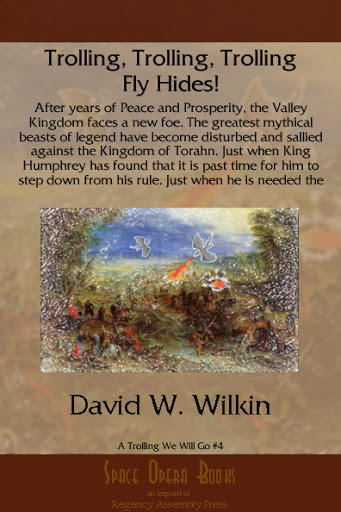
Barnes and Noble for your Nook
Old age is catching up to Humphrey and his friends. He feels it in his bones and with his son and heir having reached the prime of his life, it could very well be time to pass the baton of rule to Daniel.With the Valley Kingdom of Torahn at Peace, that would not be a terrible thing to do. Though breaking his decision to his wife Gwendolyn, the Queen, might be the hardest battle that he ever would fight.
Even as the life of retirement looks to be attractive and possible, however, the Valley Kingdom is beset again. Not Goblins, Trolls, Giants or Men, this time. No. That Humphrey knew would be far too easy.
Those obstacles had been overcome before and the problems they presented had solutions that the army of Torahn was trained to deal with. No, of all the creatures that came forth from Teantellen that they had beaten, the one they had never faced now came forth. Dragons!
Who in the realm knew how to fight these mythical beasts? Was there even away to do so?
Now Humphrey who had thought to spend the remainder of his days quietly writing his memoirs and drinking, was faced with the greatest challenge he had ever known.
Feedback
If you have any commentary, thoughts, ideas about the book (especially if you buy it, read it and like it
September 15, 2016
Regency Personalities Series-Thomas Stothard
Regency Personalities Series
In my attempts to provide us with the details of the Regency, today I continue with one of the many period notables.
Thomas Stothard
17 August 1755 – 27 April 1834
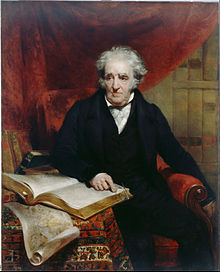
Thomas Stothard
Thomas Stothard was born in London, the son of a well-to-do innkeeper in Long Acre A delicate child, he was sent at the age of five to a relative in Yorkshire, and attended school at Acomb, and afterwards at Tadcaster and at Ilford, Essex. Showing talent for drawing, he was apprenticed to a draughtsman of patterns for brocaded silks in Spitalfields. In his spare time, he attempted illustrations for the works of his favourite poets. Some of these drawings were praised by Harrison, the editor of the Novelist’s Magazine. Stothard’s master having died, he resolved to devote himself to art.
In 1778 he became a student of the Royal Academy, of which he was elected associate in 1792 and full academician in 1794. In 1812 he was appointed librarian to the Academy after serving as assistant for two years. Among his earliest book illustrations are plates engraved for Ossian and for Bell’s Poets. In 1780, he became a regular contributor to the Novelist’s Magazine, for which he produced 148 designs, including his eleven illustrations to The Adventures of Peregrine Pickle (by Tobias Smollett) and his graceful subjects from Clarissa and The History of Sir Charles Grandison (both by Samuel Richardson).
From 1786, Thomas Fielding, a friend of Stothard’s and engraver, produced engravings using designs by Stothard, Angelica Kauffman, and of his own. Arcadian scenes were especially esteemed. Fielding realized these in colour, using copper engraving, and achieved excellent quality. Stothard’s designs had an exceptional aesthetic appeal.
He designed plates for pocket-books, tickets for concerts, illustrations to almanacs, and portraits of popular actors. These are popular with collectors for their grace and distinction. His more important works include illustrations for:
Two sets for Robinson Crusoe, one for the New Magazine and one for Stockdale’s edition
The Pilgrim’s Progress (1788)
Harding’s edition of Goldsmith’s Vicar of Wakefield (1792)
The Rape of the Lock (1798)
The works of Solomon Gessner (1802)
William Cowper’s Poems (1825)
The Decameron
His figure-subjects in Samuel Rogers’s Italy (1830) and Poems (1834) demonstrate that even in old age, his imagination remained fertile and his hand firm.
Art historian Ralph Nicholson Wornum estimated that Stothard’s designs number five thousand and, of these, about three thousand were engraved. His oil pictures are usually small. His colouring is often rich and glowing in the style of Rubens, who Stothard admired. The Vintage, perhaps his most important oil painting, is in the National Gallery. He contributed to John Boydell’s Shakespeare Gallery, but his best-known painting is the Procession of the Canterbury Pilgrims, in Tate Britain, the engraving from which, begun by Luigi and continued by Niccolo Schiavonetti and finished by James Heath, was immensely popular. The commission for this picture was given to Stothard by Robert Hartley Cromek, and was the cause of a quarrel with his friend William Blake. It was followed by a companion work, the Flitch of Bacon, which was drawn in sepia for the engraver but was never carried out in colour.
In addition to his easel pictures, Stothard decorated the grand staircase of Burghley House, near Stamford in Lincolnshire, with subjects of War, Intemperance, and the Descent of Orpheus in Hell (1799–1803); the library of Colonel Johnes’ mansion of Hafod, in North Wales, with a series of scenes from Froissart and Monstrelet painted in imitation of relief (1810); and the cupola of the upper hall of the Advocates’ Library, Edinburgh (later occupied by the Signet Library), with Apollo and the Muses, and figures of poets, orators, etc. (1822). He prepared designs for a frieze and other sculptural decorations for Buckingham Palace, which were not executed, owing to the death of George IV. He also designed a shield presented to the Duke of Wellington by the merchants of London, and executed a series of eight etchings from the various subjects that adorned it.
He married Rebecca Watkins in 1783. They had eleven children, six of whom – five sons and one daughter – survived infancy. They lived in Henrietta Street, Covent Garden, until 1794, when they moved to a house at 28 Newman Street, of which Stothard had bought the freehold. His wife died in 1825. His sons included Thomas, accidentally shot dead in about 1801; the antiquarian illustratorCharles Alfred Stothard, who also predeceased his father; and Alfred Joseph Stothard, medallist to George IV.


An Unofficial Guide to how to win the Scenarios of Wild the 2nd Expansion for Rollercoaster Tycoon 3
An Unofficial Guide to how to win the Scenarios of Wild
I have been a fan of this series of computer games since early in its release of the very first game. That game was done by one programmer, Chris Sawyer, and it was the first I recall of an internet hit. Websites were put up in dedication to this game where people showed off their creations, based on real amusement parks. These sites were funded by individuals, an expense that was not necessarily as cheap then as it is now. Nor as easy to program then as it might be to build a web page now.
Prima Books released game guides for each iteration of the game, Rollercoaster Tycoon 1, Rollercoaster Tycoon 2 and Rollercoaster Tycoon 3 (RCT3) but not for the expansion sets. And unlike the first two works, the third guide was riddle with incorrect solutions. As I played the game that frustrated me. And I took to the forums that Atari, the game publisher hosted to see if I could find a way to solve those scenarios that the Prima Guide had written up in error. Not finding any good advice, I created my own for the scenarios that the “Official” Guide had gotten wrong.
Solutions that if you followed my advice you would win the scenario and move on. But if you followed the “Official” version you would fail and not be able to complete the game. My style and format being different than the folks at Prima, I continued for all the Scenarios that they had gotten right as well, though my solutions cut to the chase and got you to the winner’s circle more quickly, more directly.
My contributions to the “Official” Forum, got me a place as a playtester for both expansions to the game, Soaked and Wild. And for each of these games, I wrote the guides during the play testing phase so all the play testers could solve the scenarios, and then once again after the official release to make changes in the formula in case our aiding to perfect the game had changed matters. For this, Atari and Frontier (the actual programmers of the game) placed me within the game itself.
And for the longest time, these have been free at the “Official” Forums, as well as my own website dedicated to the game. But a short time ago, I noticed that Atari, after one of its bankruptcies had deleted their forums. So now I am releasing the Guide for one and all. I have added new material and it is near 100 pages, just for the first of the three games. It is available for the Kindle at present for $2.99.
(Click on the picture to purchase)
Not only are all 12 Scenarios covered, but there are sections covering every Cheat Code, Custom Scenery, the famous Small Park Competition, the Advanced Fireworks Editor, the Flying Camera Route Editor which are all the techniques every amusement park designer needs to make a fantastic park in Rollercoaster Tycoon 3.
Scenarios for WILD!
1) Scrub Gardens
2) Ostrich Farms Plains
3) Egyptian Sand Dance
4) A Rollercoaster Odyssey
5) Zoo Rescue
6) Mine Mountain
7) Insect World
8) Rocky Coasters
9) Lost Land of the Dinosaurs
10) Tiger Forest
11) Raiders of the Lost Coaster
12) Saxon Farms


September 14, 2016
Regency Personalities Series-Joseph Nollekens
Regency Personalities Series
In my attempts to provide us with the details of the Regency, today I continue with one of the many period notables.
Joseph Nollekens
11 August 1737 – 23 April 1823
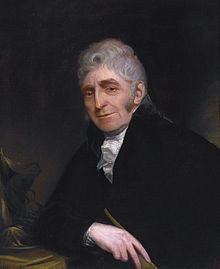
Joseph Nollekens
Joseph Nollekens was born on 11 August 1737 at 28 Dean Street, Soho, London, the son of the Flemish painter Josef Frans Nollekens (1702–1748) who had moved from Antwerp to London in 1733. He studied first under another Flemish immigrant in London, the sculptor Peter Scheemakers, before studying and working as an antiques dealer, restorer and copier in Rome from 1760 or 1762. The sculptures he made in Rome included a marble of Timocles Before Alexander, for which he was awarded fifty guineas by the Society of Arts, and busts of Laurence Sterne and David Garrick, who were visiting the city.
On his return to London in 1770 he set up as a maker of busts and monuments at 9, Mortimer Street, where he built up a large practice. Although he preferred working on mythological subjects, it was through his portrait busts that he became famous and one of the most fashionable portrait sculptors in Britain.
He enjoyed the patronage of king George III and went on to sculpt a number of British political figures, including George III himself, William Pitt the Younger, Charles James Fox, the Duke of Bedford and Charles Watson-Wentworth. He also made busts of figures from the arts such as Benjamin West. Most of his subjects were represented in classical costume.
‘Faith’, a sculpture commissioned by Henry Howard, following the death of his wife Maria in 1788 in childbirth at Corby Castle, is said to be Nollekens finest work. The sculpture can be seen in the Howard Chapel at the Parish Church of Wetheral, Cumbria.
Although he took great care over the modelling of the details of his sculptures, the marble versions were normally made by assistants, such as Sebastian Gahagan who carved Nollekens’ statue of William Pitt for the Senate House at Cambridge, and L. Alexander Goblet. Some subjects were produced in large numbers: more than 70 replicas of Nollekens’ bust of Pitt are known.
Nollekens became an associate of the Royal Academy in 1771 and a full academician the following year.
He died in London in 1823, having made a considerable fortune from his work; he left around £200,000 in his will. He is buried in Paddington Parish Church with a monument by William Behnes.
A biography Nollekens and his Times by his executor John Thomas Smith was published in 1828, portraying him as a grotesque miser. It has been described as “perhaps the most candid biography ever published in the English language”.
No. 44 Mortimer Street in Fitzrovia stands on the site of the house where Nollekens died and has a blue plaque commemorating him.


Fantasy from Space Opera Books, Trolling’s Pass and Present
Trolling’s Pass and Present
Not only do I write Regency and Romance, but I also have delved into Fantasy. The Trolling series, (the first three are in print) is the story of a man, Humphrey.
We meet him as he has left youth and become a man with a man’s responsibilities. We follow him in a series of stories that encompass the stages of life.
We see him when he starts his family, when he has older sons and the father son dynamic is tested. We see him when his children begin to marry and have children, and at the end of his life when those he has loved, and those who were his friends proceed him over the threshold into death.
All this while he serves a kingdom troubled by monsters. Troubles that he and his friends will learn to deal with and rectify.
It is now available in a variety of formats. For $2.99 you can get this fantasy adventure.
Barnes and Noble for your Nook
Years since their battles with the Trolls, even on foreign soil, the warriors of the Valley Kingdom of Torahn need something to keep their edge honed.
The economy too is beginning to fray a little without the great wars to support. The Leaders hit upon the idea of searching for a path to reach the east side of the continent.
The Elves swear that at one time their writings tell of such, the Dwarves swear such a pass across Teantellen is legendary. Teantellen though is filled with races man has never gotten along with well. Goblins, Dark Elves, Trolls, Giants and Dragons.
It has been years since the mountain tops exploded, and perhaps that has changed things enough that a way can be found to link the western lands with the eastern lands and increase trade, and prosperity for all. Even should they fail in their quest, as the history of man has shown to this point in time, the attempt will do much to spur the economy.
Tens of thousands of gold will be spent by the Council of Twenty-One to pay for such an expedition. Gold that those who are not so scrupulous might choose to pocket as they tried in the Troll Wars.
With such shenanigans taking place again, are the hopes of the previous generation, the leaders from the Troll Wars now in retirement, ready to be achieved? Is it time for Torahn, called the Valley Kingdom, but the only Kingdom without a King, to have a King once more?
Feedback
If you have any commentary, thoughts, ideas about the book (especially if you buy it, read it and like it
September 13, 2016
Regency Personalities Series-Vice-Admiral James Richard Dacres
Regency Personalities Series
In my attempts to provide us with the details of the Regency, today I continue with one of the many period notables.
Vice-Admiral James Richard Dacres
22 August 1788 – 4 December 1853
Vice-Admiral James Richard Dacres was born in Lowestoft on 22 August 1788, the son of Captain, later Vice-Admiral, James Richard Dacres and his wife Eleanor Blandford Pearce. The Dacres would eventually become a substantial naval dynasty, James’s elder brother Barrington Dacres embarked on a naval career and rose to be post-captain, while their uncle, Richard Dacres became a vice-admiral. His cousin, Richard’s son Sydney Dacres would eventually be an admiral, and First Sea Lord. James Richard Dacres entered the navy in 1796 at the age of eight, serving aboard his father’s old ship, the 64-gun HMS Sceptre, as a first class volunteer. He moved aboard the 98-gun HMS Barfleur in 1797 and was present during the expedition to Ferrol in August 1800 as a lieutenant aboard the 74-gun HMS Impetueux.
He was next reported aboard the 38-gun frigate HMS Boadicea, serving in the English Channel under Captain John Maitland. On 24 July 1803 the French 74-gun third-rate Duguay-Trouin and the 38-gun frigate Guerrière were sighted sailing off Ferrol, Spain. Maitland decided to test whether the French ships were armed en flûte and were being used as troopships, and closing to within range, opened fire. The French returned fire, revealing they were fully armed and manned, and Maitland broke off. The French pursued, but were unable to catch him. This marked Dacres’s first encounter with the Guerrière, a ship he was later to command under the British flag.
Dacres then moved to the West Indies, where his father was commander in chief of the Jamaica Station. He served for some time as flag lieutenant aboard HMS Theseus and HMS Hercule before being appointed to his first command, that of the 18-gun Cruizer class brig-sloop HMS Elk.
Dacres remained in command aboard the Elk until being transferred to the 24-gun HMS Bacchante on 14 January 1806. While in command of her he captured the 3-gun French schooner Dauphin, crewed with 71 men, off St. Domingo on 14 February 1807. He then fell in with Captain William Furlong Wise of Mediator and together they navigated the waters around Samana and planned an attack on the fort there, which was a notorious haven for privateers. The two ships mounted a four-hour-long carronade, before storming the defenders. They captured the fort, suffering two killed and 16 wounded in the process. Dacres returned to England after this, but on his arrival in December 1807 no command could be found for him and he went on half-pay.
He returned to active service again on 18 March 1811, when he was appointed to command the former French frigate HMS Guerriere, which had been captured by HMS Blanche on 19 July 1806. Dacres sailed to the North American station, and shortly after the outbreak of the War of 1812 was despatched by Vice-Admiral Herbert Sawyer as part of a squadron under Captain Philip Broke to intercept an American squadron under Commodore John Rodgers. Broke’s squadron consisted of the 64-gun ship of the line HMS Africa and the frigates Shannon, Aeolus, Belvidera and Guerriere.
Dacres briefly became separated from Broke’s squadron, and while returning to them on 17 August came across the USS Constitution, under Captain Isaac Hull. He mistook the other nearby ships, which was Broke’s squadron, for the American squadron under Rodgers, and so missed an opportunity to close on the Constitution. A chase ensued between the British and American ships, but the Constitution was finally able to escape Broke’s squadron. Dacres remained with Broke, joining him in August in escorting an inbound convoy to Halifax, after which Dacres and the Guerriere were detached to sail to Halifax and undergo a refit.
On the afternoon of 19 August the Guerriere made contact with the Constitution. Dacres prepared to fight and the two ships closed and exchanged broadsides for some time. The range eventually decreased and after a brief close exchange the Guerriere‘s mizzenmast was shot away, allowing the Constitution to rake her several times, causing considerable damage, before the two ships became entangled. Shortly after this Guerriere lost both her main and foremasts, leaving her largely un-manoeuvrable. During the engagement Dacres had been wounded by a musket-ball in the back while on the starboard forecastle, but had refused to leave the deck. Constitution then drew away to repair some damage, while Dacres attempted to set a jury rig. The attempt failed, and on Constitution‘s returning, Dacres fired a shot in the opposite direction to the Constitution. Sensing that this was an attempt to signal surrender, Hull ordered a boat to take a lieutenant over to the British ship. When the lieutenant walked onto the Guerriere and asked if Guerriere was prepared to surrender, Captain Dacres responded “Well, Sir, I don’t know. Our mizzen mast is gone, our fore and main masts are gone-I think on the whole you might say we have struck our flag.”
Dacres was brought aboard the Constitution where he presented his sword to Hull. Hull refused to accept it, saying he could not accept the sword from a man who had fought so gallantly. He also ordered that Dacres’ mother’s Bible be returned to him. The Guerriere was assessed but found to be unsalvageable, and was blown up.
Dacres briefly became a prisoner of war, but was exchanged and returned to Halifax, where he was tried by court martial for the loss of his ship, which was standard procedure in the Royal Navy for the loss of a ship at the time. He put forward as his defence the facts that the Guerriere was originally French-built and therefore not as sturdy as British-built ships, and that the Guerriere was badly decayed and on her way to refit in Halifax at the time, and the fall of the mizzen mast which crippled the Guerriere early in the fight had been due as much to rot as battle damage. There was no suggestion that Dacres and his men had not done their utmost, or that Dacres had been unwise to engage the Constitution. He was therefore honourably acquitted of all blame for the loss. He was awarded a gratuity from the Lloyd’s Patriotic Fund in consideration of his wound.
Dacres continued to serve in the navy after his acquittal, and was appointed to the new 38-gun frigate HMS Tiber on 23 July 1814. He commanded her on the Cork, Newfoundland and Channel stations until 18 September 1818. On 8 March 1815 he captured the Leo, a 3-gun American privateer under Captain George Coggeshell. He was appointed to command the 74-gun third rate HMS Edinburgh on 28 October 1833 until 1837.
A temporary fort built in 1846 at the mouth of the Fish River in the Eastern Cape Province during the Seventh Xhosa War was named Fort Dacres in his honour. The construction was carried out by sailors of the British man-of-war HMS President’.
He became a rear-admiral on 28 June 1838, and commander at the Cape of Good Hope on 9 August 1845, which was his last active employment. He was promoted to vice-admiral on 20 March 1848.
Dacres married Arabella-Boyd, sister of Sir Adolphus Dalrymple, on 25 April 1810. She died on 11 April 1828, but the marriage produced two sons and five daughters. One son, also called James Richard Dacres, died at Mozambique at the age of 37 on 14 February 1848, while in command of the sloop HMS Nimrod. Another, Hew Dalrymple Dacres died at sea at the age of 21 on 11 July 1835, having been a lieutenant in the 67th Regiment. They and their father are commemorated in a plaque in the parish church at Tetbury, Gloucestershire. James Richard Dacres died at Catisfield Lodge, near Fareham, Hampshire on 4 December 1853 at the age of 65. He was buried in the family vault at Tetbury.


RAP has The Shattered Mirror, A Regency Romance
The Shattered Mirror
For your enjoyment, one of the Regency Romances I published. It is available for sale and now at a reduced price of $3.99, and I hope that you will take the opportunity to order your copy.
Order for yourself or as a gift. It is now available in a variety of formats. For just a few dollars this Regency Romance can be yours for your eReaders or physically in Trade Paperback.
Barnes and Noble for your Nook
and in Trade Paperback
Bridget Halifax-Stokes was giddy with the excitement of her Season in London. Town had beckoned and her Season came on the heels of the end of the war against the tyrant. All the handsome men were returning heroes. What better year to come out?
Her father thought it all nonsense. Her mother believed that it would be the best showing of any of her daughters. More lords now available and the family’s luck that Bridget was just the perfect age.
All is fun and frivolity for Bridget until she literally crashes into Sir Patrick Hampton as he limps along the High Street. A man she knew once well from her childhood, now a stranger with dark and foreboding eyes. Eyes that had seen more than any man’s share of the war.
Feedback
If you have any commentary, thoughts, ideas about the book (especially if you buy it, read it and like it
September 12, 2016
Regency Personalities Series-Major-General Robert Ross
Regency Personalities Series
In my attempts to provide us with the details of the Regency, today I continue with one of the many period notables.
Major-General Robert Ross
1766 – 12 September 1814
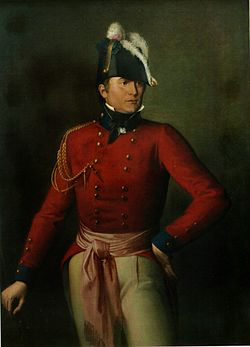
Robert Ross
Major-General Robert Ross was born in Rostrevor, County Down, Ireland, to Major David Ross, an officer in the Seven Years’ War and his mother, half-sister to the Earl of Charlemont. He was educated at Trinity College, Dublin, Ireland, where he was a treasurer of the College Historical Society and joined the 25th Regiment of Foot as an ensign in 1789.
Ross fought as a junior officer at the battles of Krabbendam in the Netherlands in 1799 and the Battle of Alexandria in Egypt in 1801. In 1803, he was promoted to major and given command of the 20th Regiment of Foot. He next fought at the Maida in the Kingdom of Naples in 1806. He was promoted to Lieutenant–Colonel at the end of 1808 and fought in the Battle of Corunna in Spain in early 1809. In 1810, Ross was made a full Colonel as well as aide-de-camp to the King.
In 1813 Ross was sent to serve under Arthur Wellesley in the Peninsular War and commanded his regiment at the battles of Vittoria, Roncesvalles, and Sorauren that year. He was seriously wounded in the left side of his neck at the Battle of Orthes, on 27 February 1814, and had just returned to service when he was given command of an expeditionary force to attack the United States.
Ross sailed to North America as a Major General to take charge of all British troops off the east coast of the United States. He personally led the British troops ashore in Benedict, Maryland, and marched through Upper Marlboro, Maryland, to the attack on the Americans at the Battle of Bladensburg on 24 August 1814, causing the hastily organised militia of the American army to collapse into a rout. Moving on from Bladensburg, Ross moved on to nearby Washington, D.C., and was fired upon; his horse was shot from under him. The public buildings, facilities and Navy Yards of the city, including the United States Capitol and the White House were burned as retaliation for destructive American raids into Canada, most notably the Americans’ Burning of York (modern Toronto) earlier in 1813, which were themselves in retaliation to British raids into the United States. Controversy surrounds Ross’s decision to destroy public property but spare private property during the burning.
Ross then was persuaded to attack Baltimore, Maryland. His troops landed at the southern tip of the “Patapsco Neck” peninsula (between the Patapsco River and Baltimore Harbor on the south and Back River on the north) of southeastern Baltimore County at North Point, twelve miles southeast from the city, on the morning of 12 September 1814. En route to what would be the Battle of North Point, a part of the larger Battle of Baltimore, the British advance encountered American skirmishers. General Ross rode forward to personally direct his troops. An American sharpshooter shot him through the right arm into the chest. According to Baltimore tradition, two American riflemen, Daniel Wells, 18, and Henry McComas, 19, fired at him and one of them had fired the fatal shot. Ross died while he was being transported back to the fleet.
Ross’s body was preserved in a barrel of 129 gallons (586 l) of Jamaican rum aboard HMS Tonnant. When the Tonnant was diverted to New Orleans for the forthcoming battle in January 1815, his body was shipped on the British ship HMS Royal Oak to Halifax, Nova Scotia, where his body was interred on 29 September 1814 in the Old Burying Ground.


Trolling Down to Old Mah Wee, another Fantasy
Trolling Down to Old Mah Wee
Not only do I write Regency and Romance, but I also have delved into Fantasy.
The Trolling series, (the first three are in print) is the story of a man, Humphrey. We meet him as he has left youth and become a man with a man’s responsibilities. We follow him in a series of stories that encompass the stages of life.
We see him when he starts his family, when he has older sons and the father son dynamic is tested. We see him when his children begin to marry and have children, and at the end of his life when those he has loved, and those who were his friends proceed him over the threshold into death.
All this while he serves a kingdom troubled by monsters. Troubles that he and his friends will learn to deal with and rectify. It is now available in a variety of formats.
For $2.99 you can get this 2nd book in the fantasy adventure series of Humphrey and Gwendolyn.
Barnes and Noble for your Nook
When the neighboring kingdom of Mah Wee begins to experience the same problems that beset Torahn some years before, they urgently request the aid of the experts in containing a new Troll infestation. But eradicating Trolls is not as easy as exterminating a few rats or mice.
Trolls are bigger than men, they are stronger than men, and then are meaner than men. Humphrey Cutter and his band of mismatched warriors must once again rise to the occasion, but can they without the aid of expertise of Gwendolyn and her particular skills?
Mah Wee, an ancient kingdom, with a monarch more steeped in the rights of being a king rather than the obligations and duties that a king should be. Here Humphrey and his crew finds that they have more than Trolls to overcome if they are to save Mah Wee from the same or nearly similar problems that they faced before in Torahn.
But, as Humphrey knows, nothing can truly be accomplished if the lovely Gwendolyn is not able to lend her aid as well.
Feedback
If you have any commentary, thoughts, ideas about the book (especially if you buy it, read it and like it







